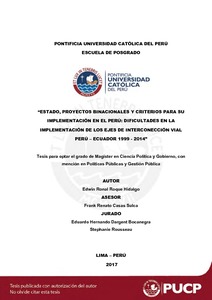| dc.contributor.advisor | Casas Sulca, Frank Renato | |
| dc.contributor.author | Roque Hidalgo, Edwin Ronal | es_ES |
| dc.date.accessioned | 2018-03-07T18:58:23Z | es_ES |
| dc.date.available | 2018-03-07T18:58:23Z | es_ES |
| dc.date.created | 2017 | es_ES |
| dc.date.issued | 2018-03-07 | es_ES |
| dc.identifier.uri | http://hdl.handle.net/20.500.12404/10266 | |
| dc.description.abstract | La presente investigación se enfoca en el estudio de las capacidades estatales para la implementación de políticas y proyectos binacionales orientados al desarrollo territorial en zonas de frontera. Así, el objetivo principal es analizar las dificultades que se presentan en los procesos de implementación de proyectos binacionales cuyos componentes nacionales deben ser ejecutados dentro de sus respectivos países. Para esto se toma como estudio de caso la implementación del Proyecto Binacional “Ejes de Interconexión Vial Perú – Ecuador”, entre los años 1999 – 2014. Proponiendo tres objetivos específicos: primero, se busca describir las características principales que presento la Política Binacional de Desarrollo e Integración Fronteriza peruano – ecuatoriana, durante su proceso de formulación. Segundo, se busca determinar las principales dificultades suscitadas en el proceso de implementación de los Ejes de Interconexión Vial Perú – Ecuador, dentro del territorio peruano. Tercero, se busca determinar cuáles han sido las consecuencias derivadas de tales dificultades, tanto para el Estado peruano, como para las poblaciones fronterizas. Desarrollando una metodología cualitativa, a través de la revisión de diversas fuentes y documentos institucionales nacionales e internacionales vinculadas al proceso, se establece que la formulación de la política binacional peruana ecuatoriana se caracterizó por privilegiar el desarrollo de las dinámicas socio económicas transnacionales, por sobre las transfronterizas, lo que repercutió en el avance de los proyectos. También se establece que el Estado peruano presenta una débil capacidad burocrática para articular adecuadamente a las instituciones locales, nacionales e internacionales, inmersas en los procesos de implementación de proyectos binacionales. La priorización en la ejecución de estos proyectos en zonas de frontera, responden a criterios institucionales basados en el uso excesivo de la
racionalidad técnica por parte de sus respectivas burocracias, las cuales privilegian sus agendas institucionales por sobre los compromisos binacionales. | es_ES |
| dc.description.abstract | The present investigation it focuses in the study of state capacities for the
implementation of binational policies and projects orientated to territorial development in border areas. Thus, the main objective is to analyze the difficulties that they present in the implementation processes of binational projects which national components must be executed within their respective countries. For this there taken as a study of case the implementation of the Binational Project "Axes of Road Interconnection Peru - Ecuador", between the years 1999 - 2014. Proposing three specific objectives: first, it seeks to describe the principal characteristics presented by the Peruvian-Ecuadorian Binational Development and integration border Policy, during its process of formulation. Second, it seeks to determine the principal difficulties raised in the process of implementation of the of the Axes of Road Interconnection Peru - Ecuador, inside the Peruvian territory. Third, it seeks determine which have been the
consequences derived from such difficulties, so much for the Peruvian State, as for the frontier populations. Developing a qualitative methodology, across the review of diverse sources and national and international institutional documents linked to the process, it is established that the formulation of the Ecuadorian Peruvian binational policy was characterized by privileging the development of transnational socio-economic dynamics, over and above cross-border, which affected the progress of the projects. It also establishes that the Peruvian State presents a weak bureaucratic capacity to adequately articulate the local, national, international institutions immersed in the processes of implementation of binational projects. The prioritization in the execution of these projects in border areas, responds to institutional criteria based on the excessive use of technical rationality by their respective bureaucracies, which privilege their institutional agendas over binational commitments. | es_ES |
| dc.language.iso | spa | es_ES |
| dc.publisher | Pontificia Universidad Católica del Perú | es_ES |
| dc.rights | info:eu-repo/semantics/openAccess | es_ES |
| dc.rights.uri | http://creativecommons.org/licenses/by-nc-nd/2.5/pe/ | * |
| dc.subject | Carreteras--Política de gobierno--Perú | es_ES |
| dc.subject | Carreteras--Aspectos políticos--Perú | es_ES |
| dc.subject | Obras públicas--Cooperación internacional--Perú | es_ES |
| dc.subject | Perú--Relaciones internacionales--Ecuador | es_ES |
| dc.subject | Ecuador--Relaciones internacionales--Perú | es_ES |
| dc.title | Estado, proyectos binacionales y criterios para su implementación en el Perú: dificultades en la implementación de los ejes de interconección vial Perú – Ecuador 1999 - 2014 | es_ES |
| dc.type | info:eu-repo/semantics/masterThesis | es_ES |
| thesis.degree.name | Magíster en Ciencia Política y Gobierno con mención en Políticas Públicas y Gestión Pública | es_ES |
| thesis.degree.level | Maestría | es_ES |
| thesis.degree.grantor | Pontificia Universidad Católica del Perú. Escuela de Posgrado | es_ES |
| thesis.degree.discipline | Ciencia Política y Gobierno con mención en Políticas Públicas y Gestión Pública | es_ES |
| renati.advisor.dni | 43305465 | |
| renati.advisor.orcid | https://orcid.org/0000-0001-8804-6086 | es_ES |
| renati.discipline | 312167 | es_ES |
| renati.level | https://purl.org/pe-repo/renati/level#maestro | es_ES |
| renati.type | http://purl.org/pe-repo/renati/type#tesis | es_ES |
| dc.publisher.country | PE | es_ES |
| dc.subject.ocde | https://purl.org/pe-repo/ocde/ford#5.06.00 | es_ES |






